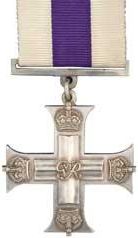Military Cross of Valour
The basis for most designs of the Military Cross of Valour is the Maltese Cross, with its distinctive wedge-shaped arms, which look very much like fish tails.
The fish symbol was adopted by the early Christian Church and the design has long been used as a Hospitaller Cross and Crusader Cross (see Amalfi Cross, the Jerusalem Cross and the Knights Templar Cross). A Vert (green) version is the St. Lazarus Cross used by The Military and Hospitaller Order of Saint Lazarus of Jerusalem. The Armenian Cross is another fishtail cross.
An interpretation different to fishtails, is of four inward-pointing arrow-heads. With this military/fighting association, the cross was the emblem of the Knights of St. John, who were driven from Rhodes to the island of Malta by the Turks. The eight-pointed cross is a symbol used by the knights to denote the eight chivalric obligations or aspirations:
- loyalty
- piety
- honesty
- bravery
- honour
- self sacrifice
- charity for the poor and the sick
- and respect for the Church.
The St. John's Cross still maintains a 'valour and rescue' image, both in civilian life and in the military, where it is often the basis of a Campaign Cross. These include the French and Belgian Croix de Guerre, Dutch Oorlogskruis, British Military Cross, US Distinguished Flying Cross, Navy Cross and Army Distinguished Service Cross. Three other famous medals using this shape were the German Honour Cross, Knight's Cross (see also the Brunswick Cross) and the Iron Cross, although the latter's image was tarnished for being awarded to soldiers later convicted of heinous war crimes. The Iron Cross was supposedly blackened to prevent the bearer from being an easy target for snipers, although it's unlikely the medal would be worn in a conflict zone.
In contrast, the modern Germany's new Honour Cross uses a bright surface and awarded only for bravery; the first being awarded in 2009 to heroes of the Afghanistan campaign (which German politicians carefully avoided calling a 'war'). This German medal has the same shape as the sinister Iron Cross, but reclaims the association with 'valour and rescue'.
The Polish Krzyz Walecznych (Cross of Valour) was introduced by the Council for the Defence of the State on 11 August 1920 during the war against the Soviet Union, and then again during the Second World War for Polish soldiers fighting alongside the Red Army.
Another pattée-shaped medal is the British Victoria Cross, instituted in 1856, during the long reign of Queen Victoria. It was first used after the Crimean War and said to have been cast from bronze barrels of Russian cannons captured at Sebastopol.
More recently (2009) the posthumous Elizabeth Cross was established for any member of the British Armed Forces who died as a direct result of military activity since the Second World War and awarded to their next of kin. The medal is made of hallmarked silver and features the rose of England, the Scottish thistle, the Irish Shamrock and the Welsh daffodil. In the centre is the crowned cipher of Queen Elizabeth II and behind the cross is laurel wreath.
Click any image to enlarge. In particular, if you enlarge the Distinguished Flying Cross you'll notice the cross has been discarded and in its place is an aeroplane's propeller.
Unfortunately, whilst these crosses are only awarded in very exceptional cases of bravery and true valour, they still conjure up an image of fighting. Contrast this with another cross, the Red Cross, and we can see these military crosses have lost most of the ethos of the eight chivalric obligations or aspirations mentioned above, or indeed, the original eight beatitudes on which all such fishtail crosses are based.
Police, fire, ambulance, rescue and other civilian support services. See for example the St. Florian's Cross.
Campaign Cross: For modern Christian campaign crosses, see Lapel Pin Crosses.








